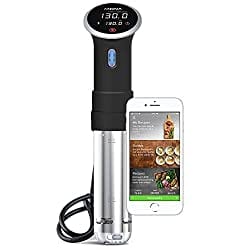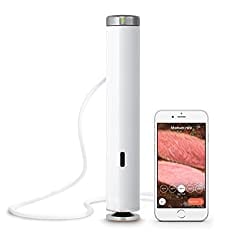Thanks to technology, anyone can become a chef in the kitchen. In today’s Tech Showdown, we’re pitting two well-loved precision cookers against each other to see which one is the worthy addition to your cooking arsenal.
The Battle of Two Sous Vide Cookers
Sous-vide is French for “under vacuum” and is a method of cooking that is believed to make cooking easy. It basically involves cooking vacuum-sealed food in a set high temperature. With help from sous vide cookers like ChefSteps Joule and Anova Culinary Precision Cooker, this typically lengthy process is made shorter.
More than just cutting the cooking time, these two are designed to make sure you enjoy evenly cooked meat every time. Imagine well-cooked salmon that melts right in your mouth… just the thought makes you hungry, doesn’t it?
Which of the two is the better deal, you ask? Find out as we weigh in both contenders’ strengths and weaknesses.
Anova Culinary Precision Cooker

Offering new chefs the simplest and easiest way to start cooking sous-vide, the Anova is a remarkable tool to have in your kitchen. It has an onboard display and controls that make it easy to use. It’s even so easy to set up. The latest model now comes with Wi-Fi connectivity, too, so you get to control the device anywhere, anytime.
ChefSteps Joule Sous Vide

No doubt, the Joule is the smallest sous vide immersion cooker that anyone has ever seen. Bring it with you and wow everyone at your friend’s party with a delightfully scrumptious steak. It’s also controlled through a mobile app so you could get it cooking even if you’re still on your way home.
Let’s ring the bell, shall we?
Price
On the surface, these two obviously have a lot in common. That includes their price tags. Both will take you back around $200 unless either goes on sale.
Verdict: Tie
Connectivity
Initially, ChefSteps Joule had the upper hand as it came with Wi-Fi connectivity. The Anova has caught up to its rival in its latest model, though. Both can now be controlled remotely via wireless Internet.
Verdict: Tie
Flexibility
Anova is bulkier and that means you can only attach it on medium or large pots. Attach its clamp on a small pot and it’s guaranteed to tip over. The Joule, on the other hand, boasts of a compact size. You could easily tuck it away in any of your kitchen drawers once you’re done using the device.
Verdict: Joule
Efficiency
Sous vide cooking traditionally takes hours to finish. The Joule and Anova cuts the sous vide cooking time in half, though the former cooks your food much faster. While it took Anova almost 20 minutes to heat six liters of waters, the Joule managed to do that in under 15.
Verdict: Joule
Control
The Joule may have a better-designed companion app, but we’re promptly giving this round to the Anova. Sure, it’s handy that you can set the timer and temperature for Joule through an app. But what if you’re handling raw meat while using the sous vide cooker? We’re sure you wouldn’t want to have to hold your smartphone just to set the timer.
Verdict: Anova
Power Consumption
Because it heats water more quickly, the Joule naturally requires greater power by design. In fact, it draws 1,100 watts of power every time. Compare that to Anova’s 900 watts.
Verdict: Anova
Conclusion
It’s clear that both Anova and ChefSteps Joule have a lot in common. In real-world applications, we doubt if anyone would notice any significant difference one might have over the other. Because both delivers on all major aspects, it all boils down to preference.
If you’re tech-savvy, go for the Joule. For average home cooks who prefer traditional-looking kitchen implements, the Anova may be better suited for them. Either way, both can fetch you mouth-watering meat recipes in no time at all!
Curious what other cutting-edge, smart kitchen devices you can introduce to your home? Well, we’ve got you a few recommendations.


